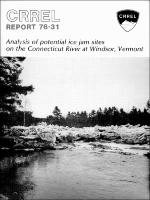Please use this identifier to cite or link to this item:
https://hdl.handle.net/11681/9535Full metadata record
| DC Field | Value | Language |
|---|---|---|
| dc.contributor | United States. Army. Corps of Engineers. New England Division | - |
| dc.contributor.author | Calkins, Darryl J. | - |
| dc.contributor.author | Hutton, M. S. | - |
| dc.contributor.author | Marlar, T. L. (Thomas L.) | - |
| dc.date.accessioned | 2016-06-20T13:42:20Z | - |
| dc.date.available | 2016-06-20T13:42:20Z | - |
| dc.date.issued | 1976-09 | - |
| dc.identifier.uri | http://hdl.handle.net/11681/9535 | - |
| dc.description | CRREL Report | - |
| dc.description | Abstract: Sections in the Connecticut River where ice jam potential is high were identified through the use of low-altitude black and white photographs taken during low-flow, ice-free conditions. The hydraulics and mechanics of ice jam initiation were investigated in the river reach where these sections were identified. Certain areas were found in the river that had a high susceptibility to ice clogging, but this high potential decreased with increasing discharge because of the improved surface conveyance of the ice through the reach. The stability of ice floes was established along the channel, but the floes generally became unstable as the flow increased. This was calculated by using a Froude number criterion. Grounding locations for ice became evident when the critical Froude number was zero for a given thickness and water depth. No single factor was determined to be responsible for initiating the ice jams in the Connecticut River at Windsor. Apparently there existed a multitude of interacting conditions: surface constrictions, possible high backwater conditions from the Brattleboro Dam, a solid ice cover in the backwater of the Brattleboro Dam that prevented ice transport from the Windsor area, deep pools followed by shallow depth sections upstream of bridge piers, a greater ice thickness accumulation of fragmented floes than would result if a uniform cover could be established in the same reach, and the diurnal fluctuation of river stage caused by the release of water at Wilder Dam. | - |
| dc.publisher | Cold Regions Research and Engineering Laboratory (U.S.) | - |
| dc.publisher | Engineer Research and Development Center (U.S.) | - |
| dc.relation | http://acwc.sdp.sirsi.net/client/en_US/search/asset/1011480 | - |
| dc.relation.ispartofseries | CRREL report ; 76-31. | - |
| dc.rights | Approved for public release; distribution is unlimited. | - |
| dc.source | This Digital Resource was created from scans of the Print Resource | - |
| dc.subject | Aerial photographs | - |
| dc.subject | Channel morphology | - |
| dc.subject | Connecticut River | - |
| dc.subject | Windsor, Vermont | - |
| dc.subject | Hydraulic analysis | - |
| dc.subject | Ice | - |
| dc.subject | River ice | - |
| dc.subject | Ice jams | - |
| dc.subject | Ice jam locations | - |
| dc.title | Analysis of potential ice jam sites on the Connecticut River at Windsor, Vermont | - |
| dc.type | Report | en_US |
| Appears in Collections: | CRREL Report | |
Files in This Item:
| File | Description | Size | Format | |
|---|---|---|---|---|
| CR-76-31.pdf | 6.88 MB | Adobe PDF |  View/Open |